Which Of The Following Correctly Lists A Food Or Animal And Its Native Land

Larn all nearly Iceland wildlife in our detailed guide. Despite existence a stark, volcanic land with little vegetation, Icelandic wildlife and animals have evolved and adapted to the conditions. Discover animals native to Iceland, including those that contribute to the state's distinct national character. Read ahead to learn about the animals of Republic of iceland.
Before humans settled Republic of iceland in the 9th century, information technology had merely 1 state mammal, the Arctic fox. The rest of the creatures were either birds or marine animals. However, a millennium later, a wealth of life has adjusted to the harsh climate.
From its unique domestic livestock, which quite literally kept Icelanders alive during their most trying times, to the creatures that accept escaped captivity and formed a wild population, the animals of Republic of iceland are thriving. They're function of what pulls guests here from around the world.
Domestic Animals in Iceland
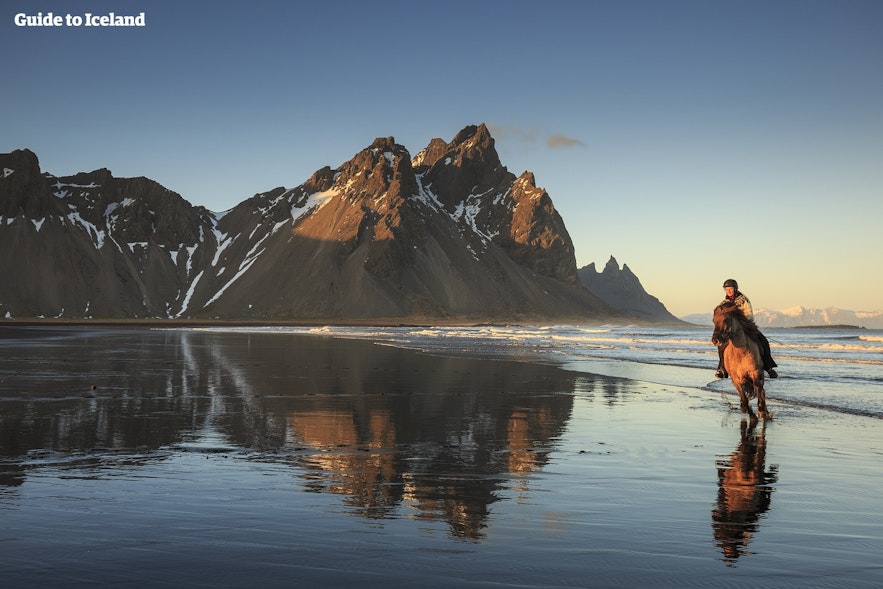
The vast bulk of animals in Iceland that you'll see are domestic. After all, this is a nation that relies heavily on agronomics.
While farm animals may not seem to exist fascinating creatures, the way they have adapted to the state'southward climate, and their roles throughout Icelandic history, have been essential for homo survival.
The Icelandic Sheep
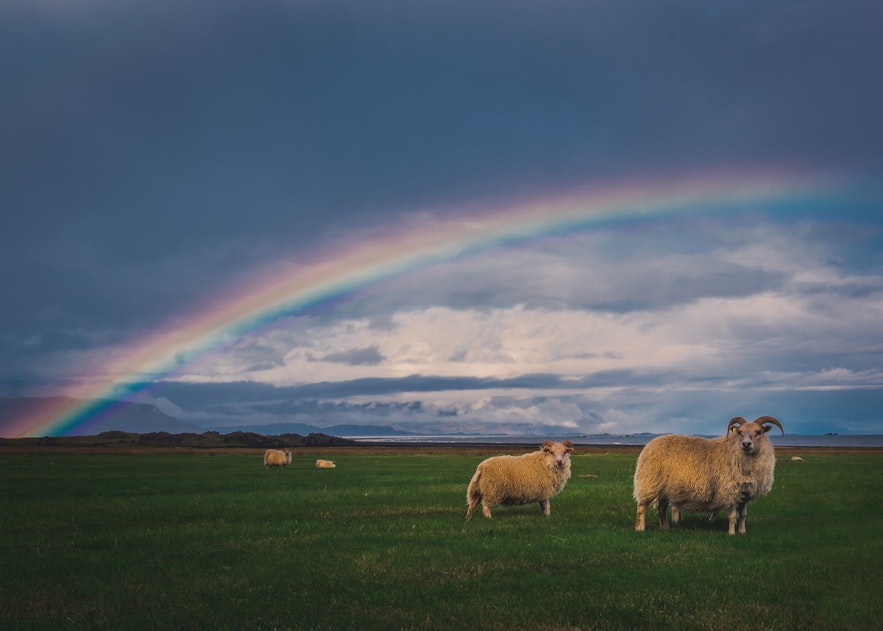 Photo by Cosmic Timetraveller
Photo by Cosmic Timetraveller
Sheep were the lifeblood of Iceland for centuries. The kickoff settlers from Norway brought them to the island, and their wool and meat helped humans survive Iceland's harsh conditions.
To understand Icelanders' reverence for these creatures, one only needs to read Nobel Prize winner Halldor Laxness's novel . They're the central conversation topic betwixt most of the country folk.
While not being the most exciting animals in Republic of iceland, their role in the country's history has been incredibly significant. Whenever the nation has gone through terrible struggles or a surge in growth, it has always returned to sheep.
For example, the 1783 eruption of the volcano Laki was the near fatal in the country's history.
Up to 25 pct of the population died, primarily considering of famine caused past the 80 percent of the nation's sheep lost to the ash's poisons.
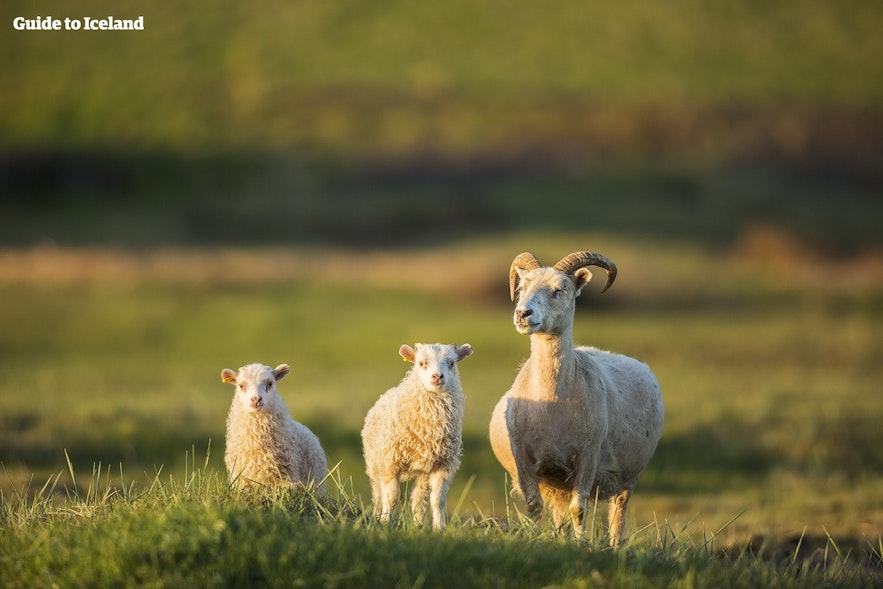
On the other hand, Republic of iceland's meaning growth and industrialization during World War One were also due to these creatures.
With the European countryside ravaged by war, Icelandic wool was in high demand. The wealth that came from sheep products during these four years helped propel Iceland into becoming the modern nation it is today.
There are approximately 800,000 sheep in Republic of iceland, more than than double the number of people.
Their wool is used to create unique handicrafts, such as the Icelandic sweater, otherwise called a "Lopapeysa." Their meat features in almost all traditional dishes that do non have fish.
Perhaps the nation's about archetype dish is lamb soup, which is globe-renowned.
The reason Icelandic lamb tastes as delicious equally it does is rather morbid. The sheep are free-roaming throughout summertime, and they graze on Icelandic thyme, unwittingly flavoring their meat while they're still alive.
The Icelandic Sheepdog
 Photo by Ulf Bodin
Photo by Ulf Bodin
Like the livestock of Iceland, Icelandic sheepdogs developed from their Nordic cousins when brought to Republic of iceland by early settlers hundreds of years agone.
Since and then, they accept been essential in aiding farmers, herding, and guarding property.
Like most animals brought to Iceland, they're smaller than their relatives away. They're also much more susceptible to illness due to Iceland'due south isolation, to the extent that they faced extinction from the late 19th century.
Afterward a ban of other canis familiaris breeds inbound the land and afterwards pet vaccines and modernistic veterinary care that made this first step redundant, the population has recovered.
Other than their size, Icelandic sheepdogs share the same fluffy coat and curled tails every bit other sheepdog breeds.
They likewise share the same behavior. The sheepdogs are highly energetic, resilient, agile, and friendly, making them great companions for those with the time and space to allow them exercise.
The vast majority of individuals live out in the state, where they can utilize their high energy and natural herding instincts to help their owners.
The Icelandic Equus caballus
Icelandic horses are not at all like other breeds. At starting time sight, information technology appears that they only differ in terms of elevation, as they rarely reach 59 inches (150 centimeters) tall.
After a few minutes in their company, however, it becomes apparent that Icelandic horses are more friendly, curious, and intelligent than other horses. These graphic symbol traits have made them a central part of Icelandic identity.
The reason for their unique charm is due to their descendants. Merely ane equus caballus could fit within a longboat when Iceland was get-go settled.
Since many of the early settlers were wealthy chieftains, they would only take the very best of their stock with them. That meant that, every bit the settlement period concluded, Iceland had a healthy population of the sturdiest, strongest, and near intelligent horses from Kingdom of norway.

Icelandic horses are not particularly concerned past Iceland'south winter weather condition.
Initially, the horses were almost solely used for transportation and sometimes battles between clans.
Over the centuries, however, they were used more and more for subcontract work and became central to the nation's survival.
Those in possession of a horse were able to travel from the land to the towns and trading posts, allowing them to develop more wealth and opportunity. Those without one were left isolated and more than impoverished as a result.
Every bit equestrian sports became more than and more pop, Icelandic horses became noted for something else - while virtually breeds around the globe take 3 or four "gaits" (style of walking, such as the trot and gallop), Icelandic horses had v.
Their unique gait, the "skeid," is a style that adult due to Republic of iceland'due south rough terrain and is noted for being comfortable with the potential for rapid dispatch.
- See also: The Icelandic Horse | A Comprehensive Guide
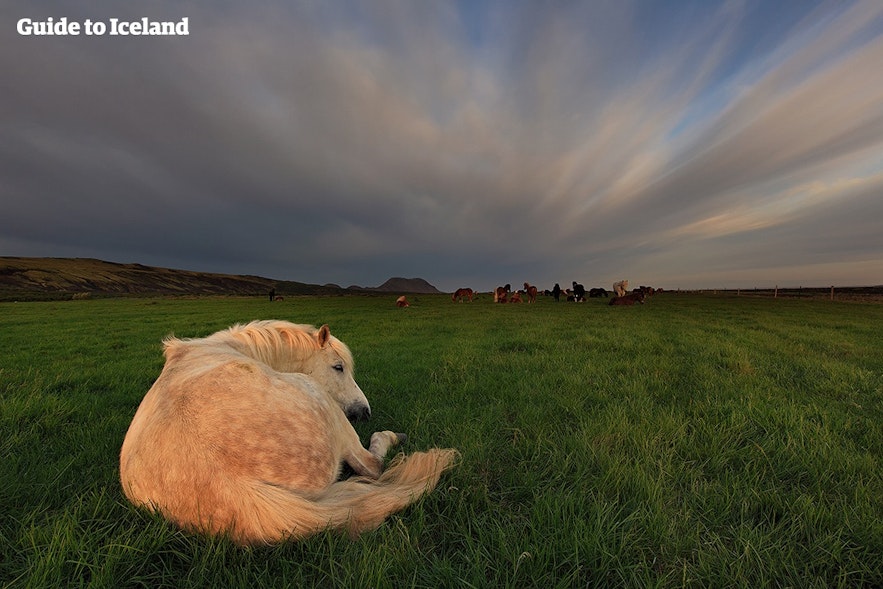
Icelandic horses are popular for dressage, riding, and their meat.
Icelandic horses have become very pop in dressage because of their character, appearance, and unique qualities.
More than Icelandic horses at present alive outside the country than inside; 100,000 alive abroad, compared to the fourscore,000 living domestically.
Those who leave Iceland can never return, and no other breeds are allowed on the island. These restrictions are because the isolated native breed is susceptible to diseases, and a foreign infection could cripple the whole population.
Riding an Icelandic horse is equally near to an essential Icelandic feel every bit there is.
In that location'south a wealth of horse-riding tours beyond Iceland. Because they usually only last a few hours, combining this excursion with many others, such equally snorkeling, caving, or sightseeing effectually the Aureate Circle, is possible.
Cattle in Iceland
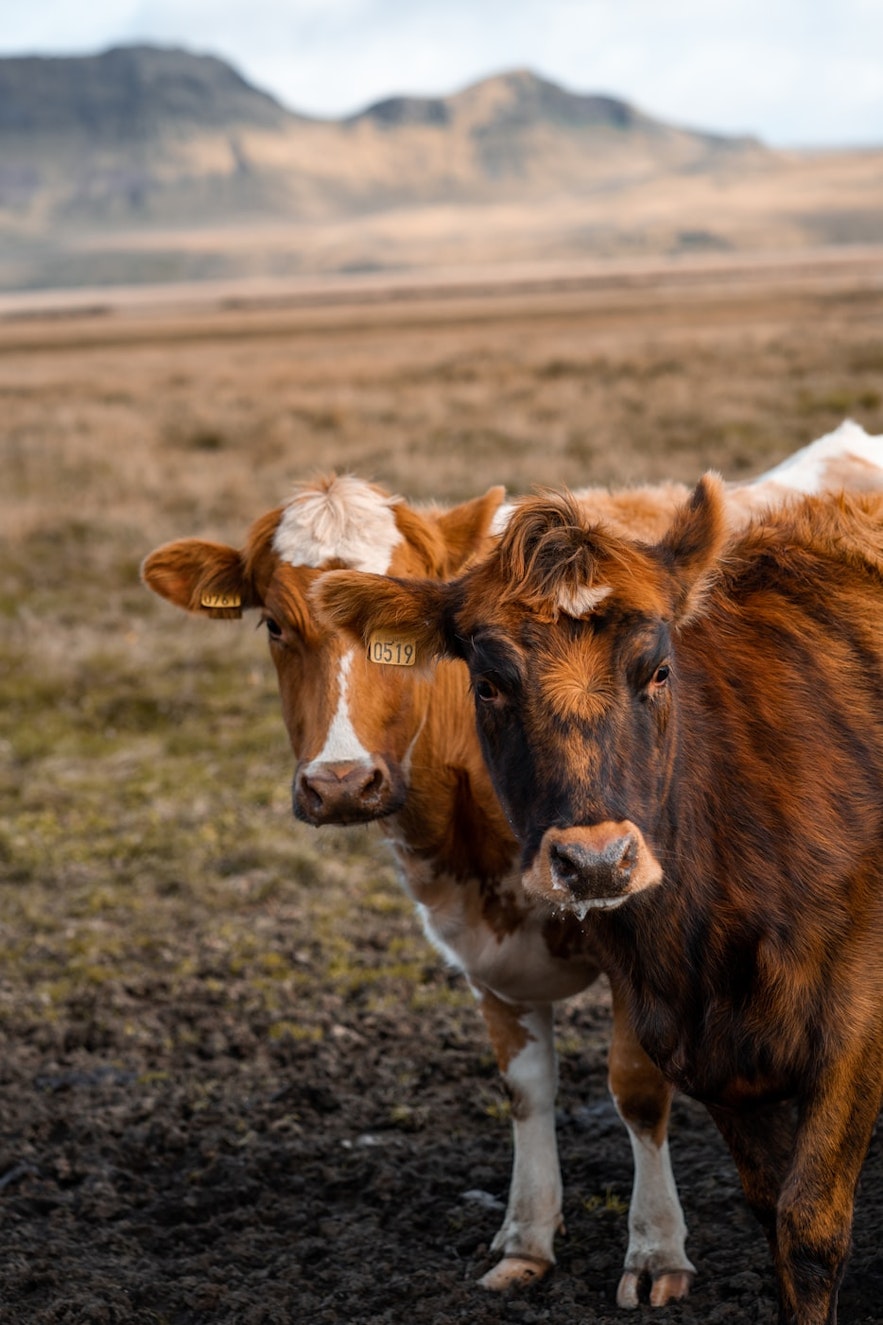 Photograph past Kristoffer Jensen
Photograph past Kristoffer Jensen
A less commonly seen farm animal in Iceland is the cow, but the state does take a unique breed. Like the horses, Icelandic cattle were brought over with Kingdom of norway's earliest settlers and take since developed unique traits. They are, for example, smaller than their European counterparts and very susceptible to foreign diseases.
Unfortunately, while Icelandic horses' other qualities compare favorably to like breeds worldwide, the qualities of Icelandic cattle do not. The Agricultural University of Republic of iceland recently released a study saying that Swedish cows would produce more milk at a lower cost than the native breed and suggested that making the switch would benefit the economy.
Although the Icelandic population is non equally connected to their cows as to their horses, at that place was all the same resistance to this thought.
For a millennium, Icelandic cattle have produced essential dairy products, many of which have get an integral office of the nation's culture. I particularly notable example is Skyr, a thick, yogurt-like cheese. For this reason, many consider them too crucial to Icelandic heritage to desert. The cows are as well favored for their diverse colorations and patterns.
Not-Native Wildlife in Iceland
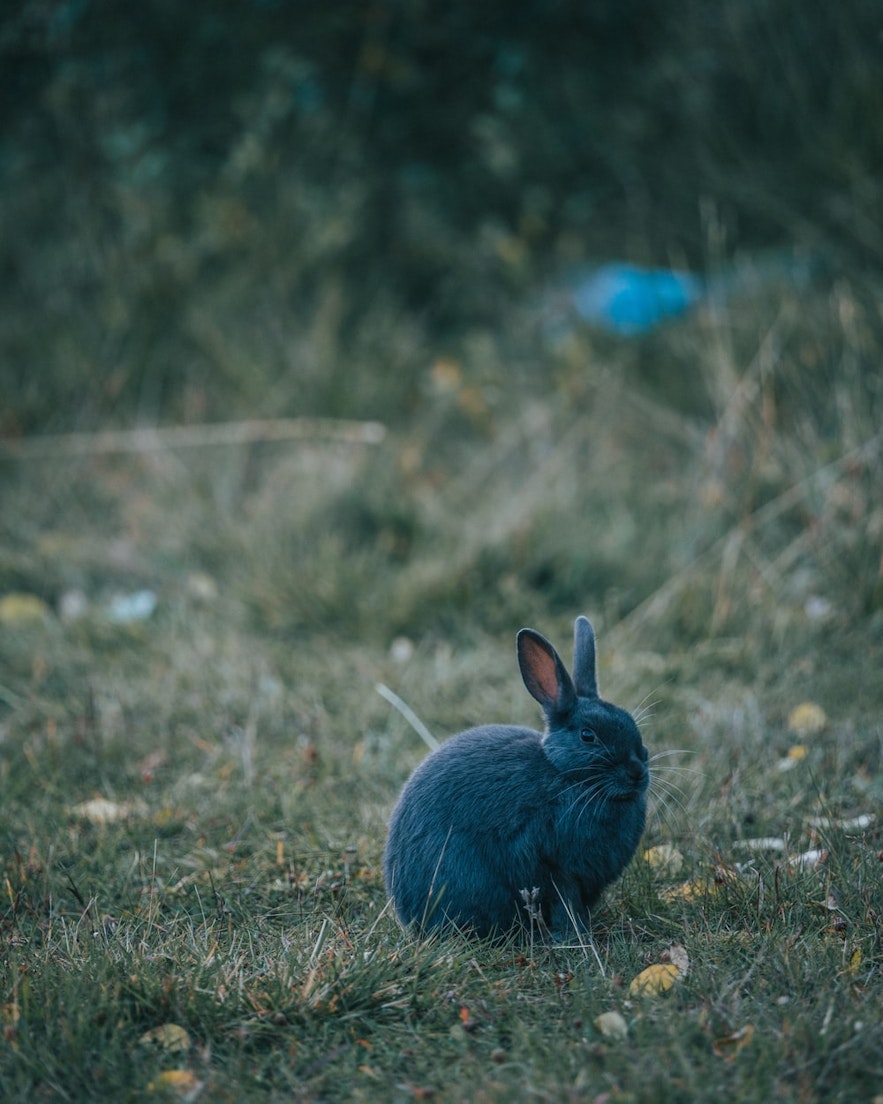 Photo by Tamas Tuzes-Katai
Photo by Tamas Tuzes-Katai
Republic of iceland simply had one native state animal when the Norse kickoff arrived here. Today, there are multiple species to be institute across the country.
None arrived naturally, either being brought over by humans or sneaking across on boats, just all have established themselves successfully, for improve or worse.
Reindeer in Due east Iceland
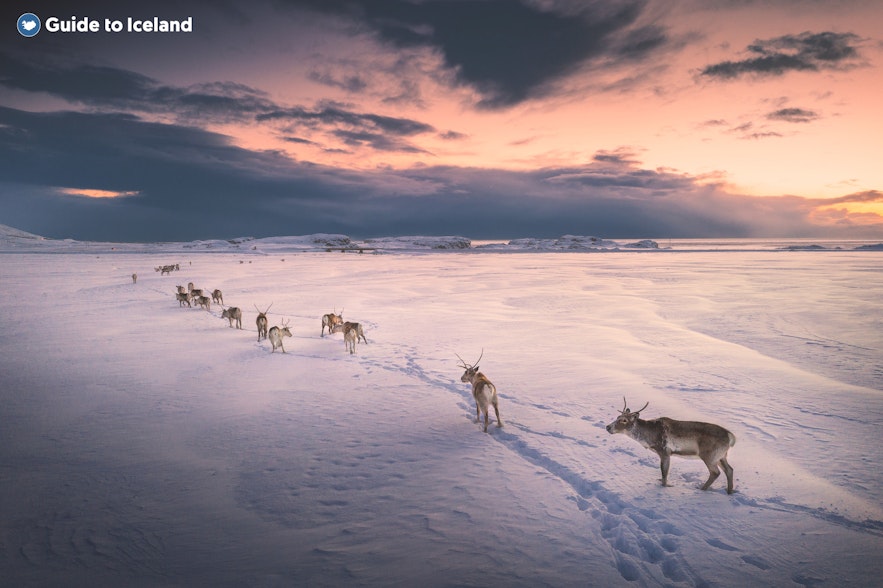
Reindeer in east Iceland are a common sight.
Reindeer were brought over to Iceland much later than domestic animals in the 18th century.
Initially, they were supposed to exist farmed as they were beyond Scandinavia, but Icelanders never took to the exercise. The population, therefore, became wild.
Well-nigh 3,000 reindeer at present alive in the land, concentrated in the Eastward. The reindeer are about commonly institute around Snaefell, on the higher basis throughout summer and in the warmer lowlands through winter. Still, they have been seen as far south as Jokulsarlon and equally far north every bit Vopnafjordur.
Those driving through or staying in the Due east Fjords have a reasonable run a risk of spotting a herd.
While the reindeer are well-loved across Iceland, their population is controlled seasonally, equally it is a concern that they may take food away from the grazing lands used past the complimentary-roaming sheep.
This consumption would cause significant damage to the economy in the case of a vicious winter or a large-calibration volcanic eruption, both of which are not uncommon in Iceland.
Rodents and Mink in Republic of iceland
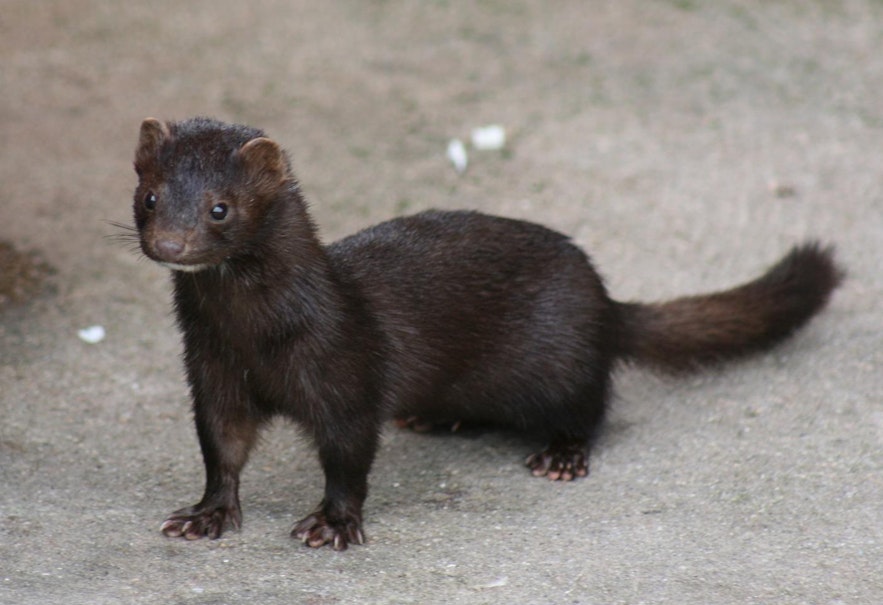
Throughout history, whenever humans discovered and settled new lands, they brought rodents with them, and Iceland is no exception.
Along with wood and house mice, brown rats came over either with early settlers or later with trading ships and formed populations. The rats primarily alive in populated areas, while the mice have spread all across the country.
Iceland also has a population of wild mink that was established more recently. They were imported for fur farms throughout the early on 20th century but escaped and became feral.
They're often spotted fishing in the waterways around Reykjavik and hunting for bird eggs along nesting cliffs and have get the bane of chicken farmers across the state.
Rabbits are another invasive species and came even more than recently than the mink. The bulk of the rabbits are descendants of pets released in 2010. Now, they have spread across the land and wreak havoc wherever they go.
In Oskjuhlid, a forested expanse in Reykjavik, they gnaw through tree roots and fences, dissentious nature and human constructions alike.
In farms across the land, they dig into and ruin hay meant for other animals, and their habit of running into the roads has caused several crashes.
Yet, they brand for a charming sight in the capital'due south green spaces.
Native Wildlife in Iceland

Subsequently reading this far, you might exist wondering what animals are native to Iceland. As has been noted, Iceland has simply one indigenous state mammal. Notwithstanding, that is not to say that the native wildlife of Republic of iceland lacks diversity.
There's a wealth of Iceland animate being in the country's seas and skies, which depict visitors worldwide. It'due south ane of the best places to visit for bird watching, seal watching, and whale watching.
Arctic Foxes of Republic of iceland
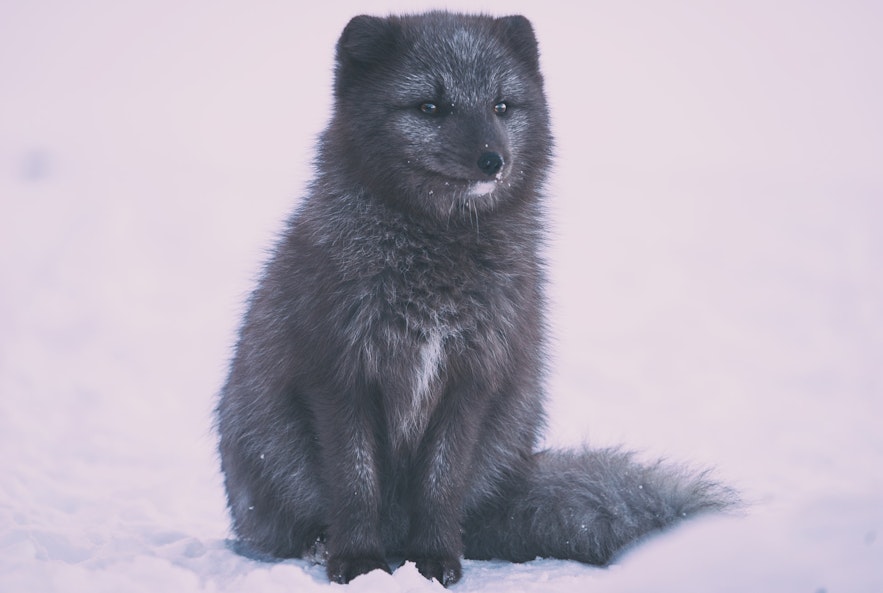 Photo by Jonatan Pie
Photo by Jonatan Pie
Before man settlement, Arctic foxes were the only state mammal that lived in Iceland. They walked over sea ice to the island during the last ice age, but to be stranded there when it melted over x,000 years ago.
Incredibly adaptable creatures, they managed to sustain themselves past feeding on eggs, birds, invertebrates, and berries.
The foxes were hunted extensively for fur and livestock protection when humans arrived. With the development of fur farms, the sometime reason no longer applies, simply farmers still maintain that population control is essential for their economic system.
While hunting disrupted the fox populations, human arrival meant a wealth of new food in rodents, nutrient waste matter, and lambs, allowing the species to survive.
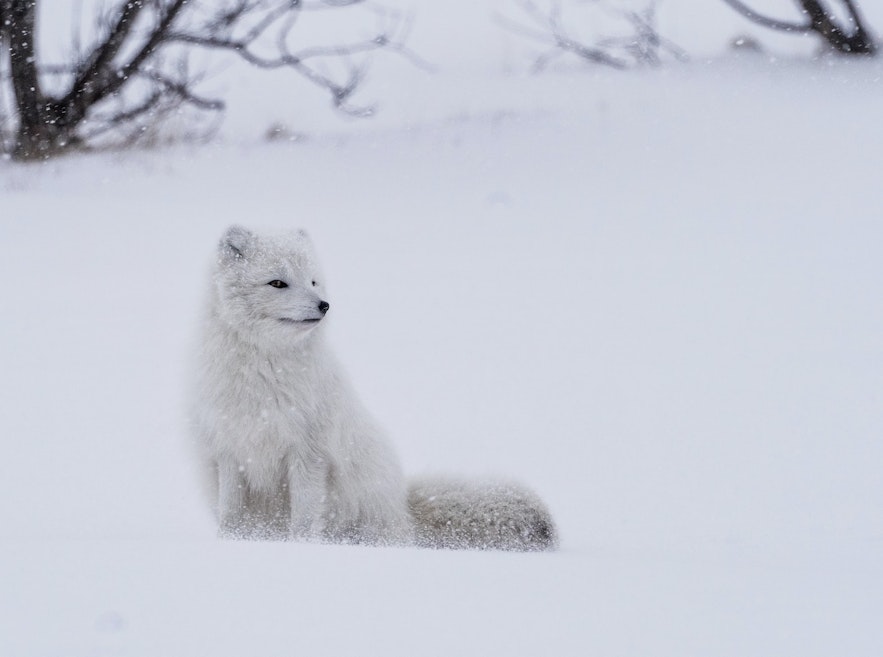 Photo by Jonatan Pie
Photo by Jonatan Pie
The Arctic foxes in Republic of iceland come in two colors, white and blue. White foxes alter their coat completely between seasons, going from snow-white in winter to brown and white in summer.
Blue foxes do not change coat, simply their fur is bleached throughout summer so that they're much lighter by the inflow of winter.
Yet, both variants thicken their fur throughout the colder months and lose it when the weather condition warms.
Arctic foxes can be institute across Iceland simply are mainly concentrated in the Westfjords. Here, you can find them in the very north of the remote Hornstrandir Reserve, where they're protected.
They're pretty fearless of humans in this region, and then wildlife photographers often come up for some very intimate shots.
Since 2007, at that place has been an Arctic Pull a fast one on Center in the village of Sudavik. The heart has led the fashion to enquiry these animals, brainwash people almost their threats, and promote eco-tourism.
Whales of Republic of iceland
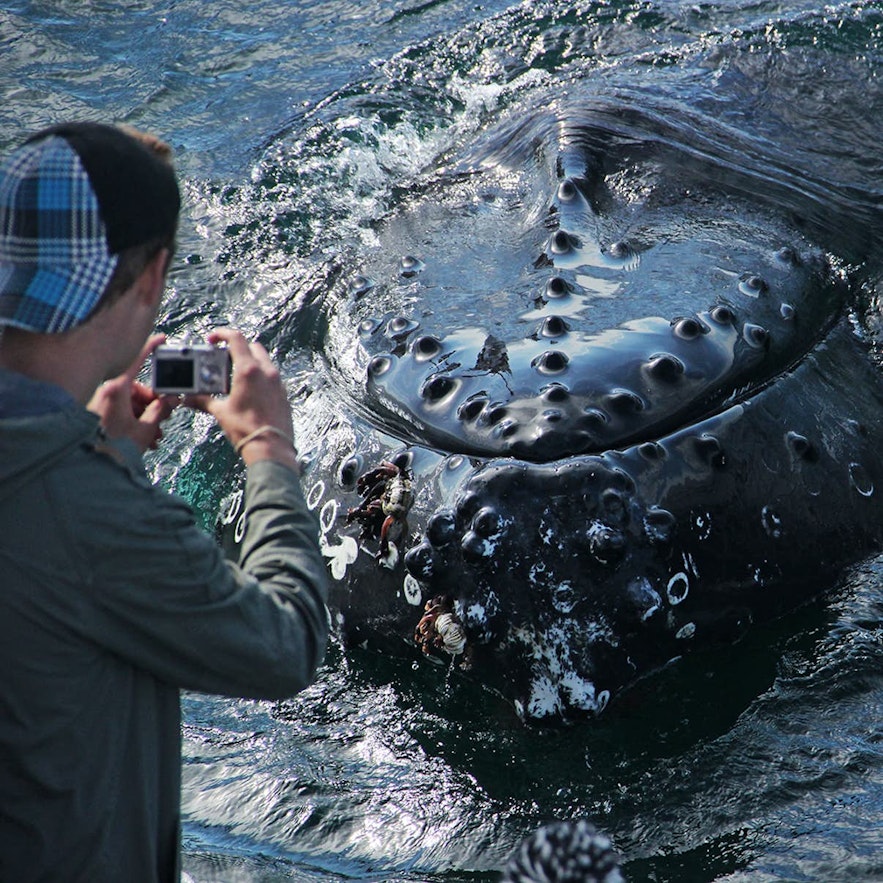 Picture from Húsavík Traditional Whale Watching
Picture from Húsavík Traditional Whale Watching
Iceland's fertile sub-Arctic waters, fed by the Gulf Stream, are dwelling to over 20 different whale and dolphin species.
It's ane of the all-time places in the world for whale watching, specially during the summer when the great whales migrate here to feed.
This industry is changing how Icelanders view the creatures of the deep, as the human relationship between the two is historical and complex.
As seafarers, many accounts from early Icelanders depict whales as terrible leviathans. An incredibly famous story tells of a warlock who attempted to take over Republic of iceland by transforming into a whale before beingness rebuffed by a dissimilar guardian spirit on all four shores.
- See likewise: Whale Watching in Iceland
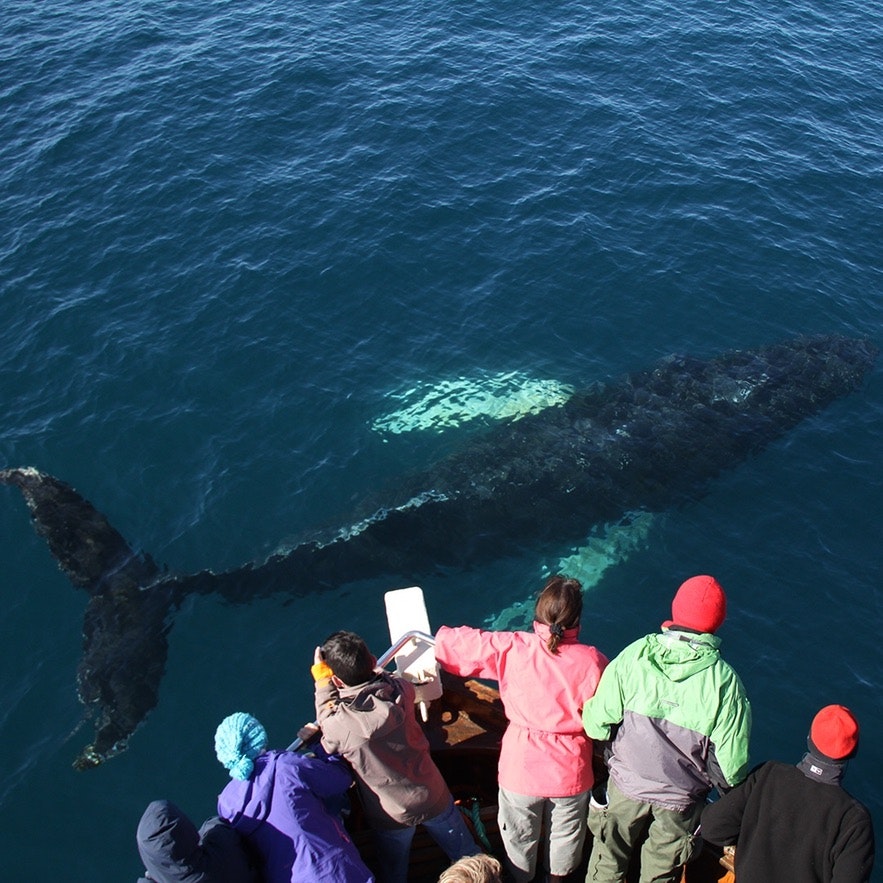
However, while feared when in their natural environment, whales were hugely appreciated when they washed up on the beaches.
The meat from a unmarried stranding could feed communities, and their oil could supply candles and lanterns to help sustain people through the night winters. The word for "windfall" in Icelandic is the same as a beached whale.
Republic of iceland began commercial whaling in the belatedly 19th century, afterward than most other nations, and struggled with the pressures confronting it for many decades.
Commercial whaling has been outlawed then reinstated several times due to stock populations, international pressure, and local opinions.
While whaling continues today, it is a constant contend within the country about whether it has a future.
What indeed does have a future, however, is whale watching. Tours are leaving from ports all across the state, with incredibly loftier success rates and a diverse wealth of life to meet.
The best place to go whale watching is in Husavik, renowned for being the whale capital of Iceland.
Seals of Iceland
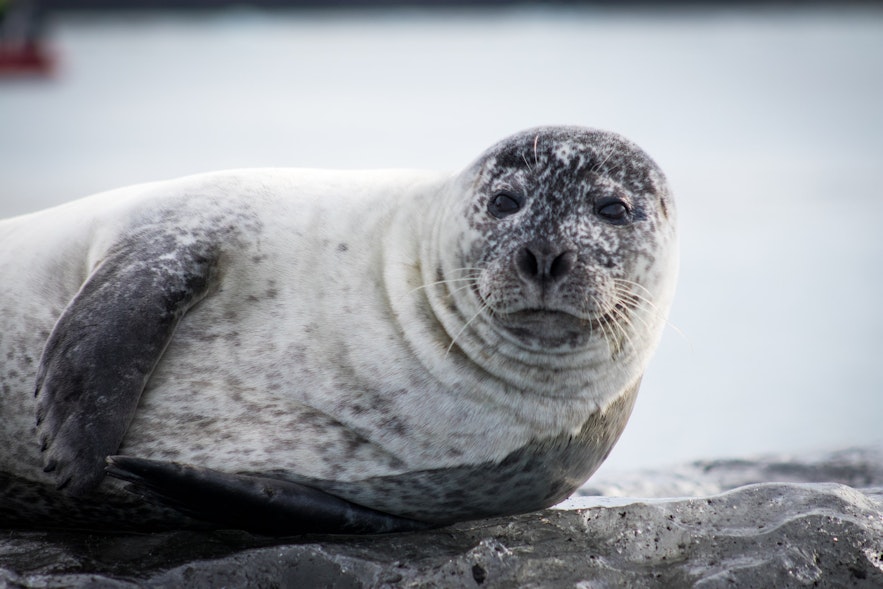 Photograph past Jane Yeo
Photograph past Jane Yeo
Seals have used Iceland's shores as a identify to haul out, breed, and shed for millenniums. Its cold, fertile waters, and long stretches of rocky, uninhabited declension, immune big colonies to evolve before humans always set foot here.
Their numbers and lack of fearfulness of humans were a blessing when settlers did arrive. Seals provided the people with essential resources, from food to clothing to oil, which helped make the stark new country habitable.
Their populations were dwindling heavily past the 20th century when more and more were taken for fashion rather than necessity, but their numbers today are relatively stable.
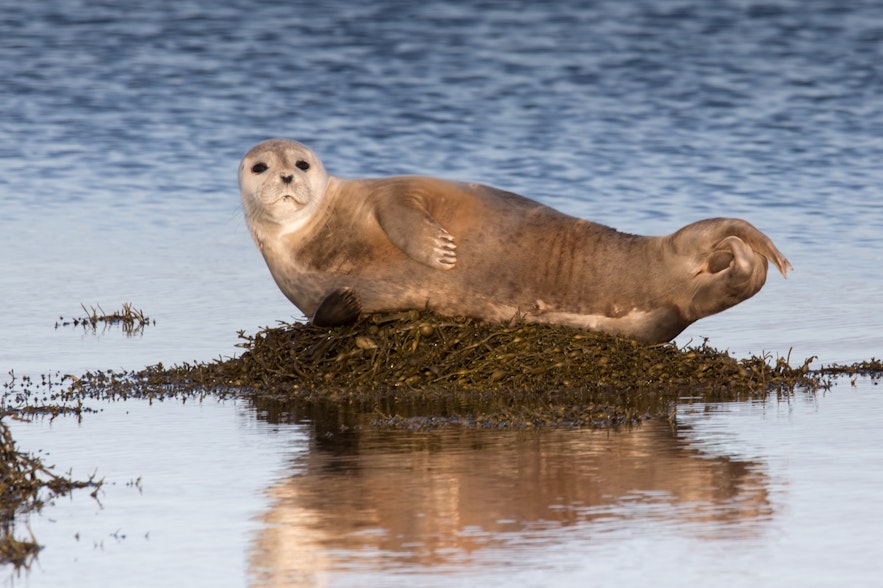 Photo by Einar Jonnson
Photo by Einar Jonnson
Seals are all the same hunted occasionally in Iceland due to their impairment to fishing equipment and passing ringworm to fish stocks. Some are however hunted on private belongings for fur.
These practices take come under increasing examination as the seal-watching industry has boomed, peculiarly since the opening of the Icelandic Seal Center in Hvammstangi, dedicated to researching these animals and raising awareness about their threats.
Two seal species live permanently on Iceland'due south shores: the harbor seal and the grey seal.
They live all around Iceland, simply the all-time places to spot them are the Westfjords, the Vatnsnes Peninsular, the Snaefellsnes Peninsula, and the Jokulsarlon glacier lagoon.
They're not the only species to frequent Icelandic waters, notwithstanding. Harp, bearded, hooded, and ringed seals are occasional visitors, and even walruses are sometimes seen in the Westfjords.
Walruses used to have a large population here but were hunted to extinction in the 17th century.
- Learn more almost Seals and Seal Watching in Iceland
Puffins of Republic of iceland
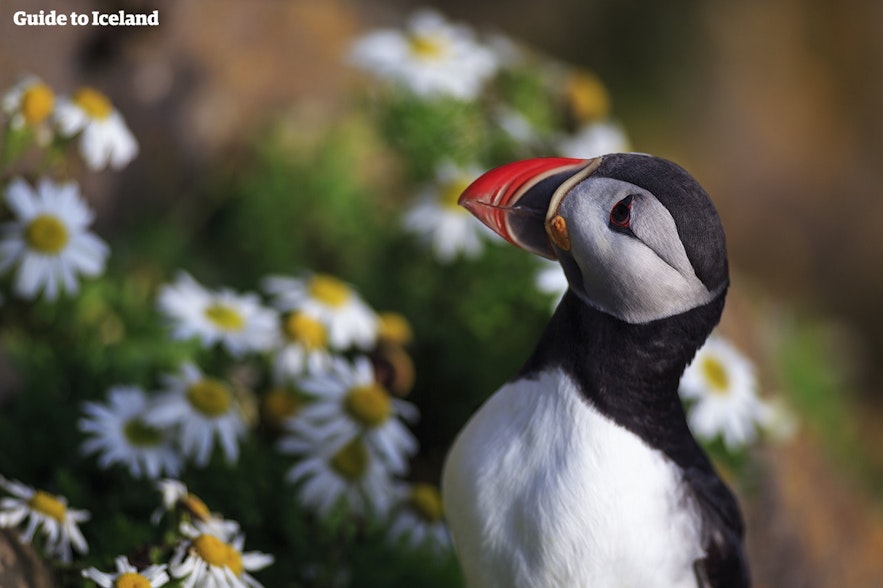
Puffins are considered rare and elusive birds in well-nigh of the world, only in that location's a wealth of them in Iceland.
Their arrival in April and May marks the starting time of summertime, and they tin be easily seen upward close in many parts of the country until August.
Approximately 60 percent of the world'due south North Atlantic puffins breed in Iceland'southward cliffs, and millions of nesting pairs exist.
These birds do not like to roost anywhere where there are no others of their species, and then wherever you can find one, you are likely to run into hundreds more than.
Puffins can be appreciated by boat and past land. From Reykjavik's Old Harbor, it's piece of cake to leap on an hour-long tour to one of two islands, Lundy and Akurey, only out in the bay, where they nest in the thousands.
These vessels are modest enough to get close to the rocky shores, and many tours include binoculars so you lot can see them even more clearly. Many whale-watching tours also include a detour to these islands.
- Detect Where to Find Puffins in Republic of iceland
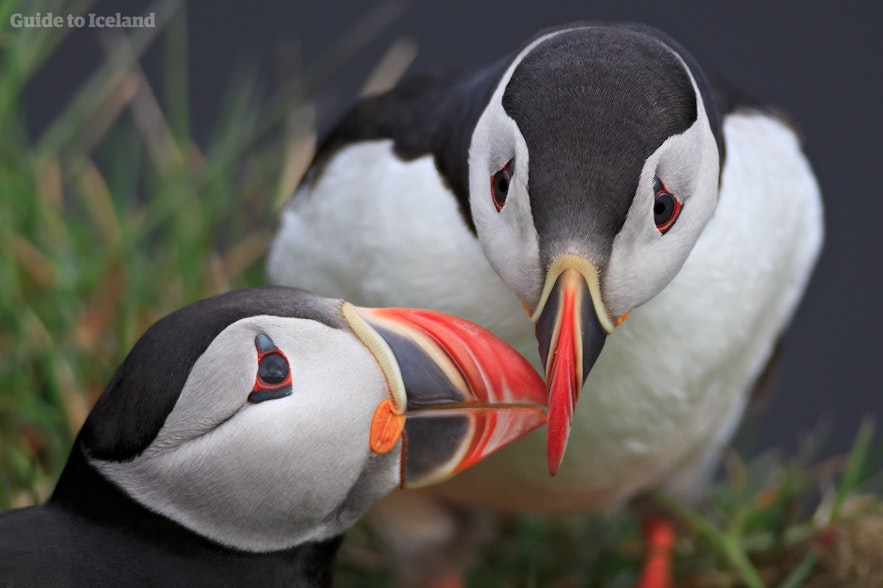
Those traveling to the Westfjords need not even board a boat to run across puffins in summertime. The Latrabjarg cliffs, which are upward to 1,444 anxiety (440 meters) high and stretch for 8.7 miles (fourteen kilometers), are impressive in their own right, just the wealth of birdlife makes them awe-inspiring.
Walking forth the border of this cliff makes information technology possible to get within arm's length of the nesting puffins. They accept no fear of people and will only fly off if someone tries to affect them. At such proximity, the details of their painted beaks and adorable expression are on articulate display.
These are not the only places puffins nest, however. Y'all can discover them in huge populations around the Westman Islands, on the Dyrholaey rock curvation, in the East Fjords, and Grimsey Island in the North.
As is well-documented, Icelanders take quite a penchant for unusual meats. Therefore, it's the merely land in the world where you can spend the day watching puffins, and so bask one for dinner.
Other Birds of Iceland
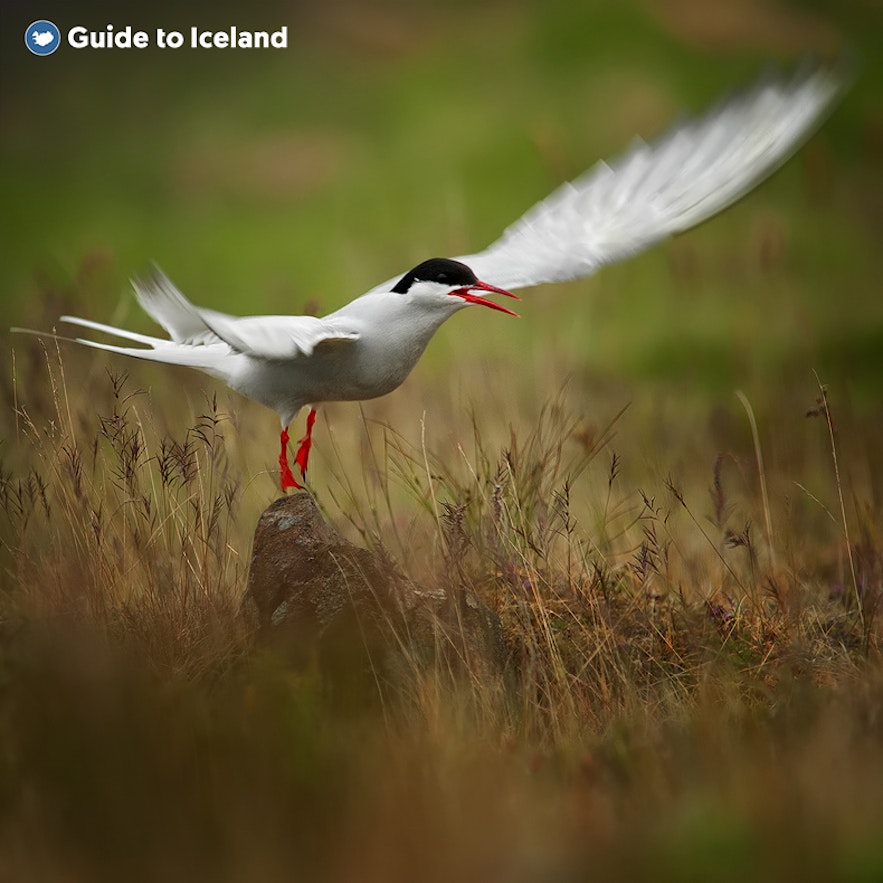
Puffins are the nearly popular bird in Iceland, but this tiny island has an enormous wealth of avian life.
The cliffs of Latrabjarg in the Westfjords and Krysuvikurbjarg on the Reykjanes Peninsula are dwelling house to thousands of individuals and many different species, such equally guillemots, fulmar, gulls, auks, sandpipers, and peewits.
You can also find Arctic terns and ocean eagles around the coasts. In that location'south an equal amount of variety in freshwater; Myvatn Lake alone is habitation to 14 different duck species and geese and whooper swans.
Outside of aquatic environments, in that location are even more species: gyrfalcons, golden plovers, snipes, and ptarmigans all phone call the isle domicile.
Withal, no discussion virtually the birds of Iceland would be complete without a mention of the raven. While this is one of the world's nearly widespread animals, they're ubiquitous here and revered for their intelligence and importance to Icelandic sociology and pagan beliefs.
- Learn more than nigh The Birds of Republic of iceland
Polar Bears from Greenland
 Photograph by Hans-Jurgen Mager
Photograph by Hans-Jurgen Mager
The polar comport is not i of the native Icelandic animals just an exceptional visitor from Greenland.
Contrary to what many recall, polar bears exercise not have a permanent population in Republic of iceland. Occasionally, however, they come up from Greenland on ice-floes and land in the Westfjords.
Unfortunately, when they make it, they're likely to be starving, and therefore pose a pose a significant threat to those living in the region.
Considering this and the cost of capturing, bringing to health, and returning the polar acquit to its home (estimated at 85,000 USD), they're killed upon arrival.
The terminal polar bear seen in Iceland was in July 2016. As the climate changes and more ice melts, it's expected that more and more will start to arrive.

In just over a millennium, Iceland has come a long way from beingness a stark island with only one creature walking its land.
Now, if you travel through any function of the country, you'll at least run across a vast wealth of domestic life thriving in the harsh climate. Yous are probable to find much more if you know where to await. From the dandy whales to the runaway rodents, Iceland's animals and wildlife are e'er shaping this nation'due south grapheme.
Whether you're interested in learning virtually Republic of iceland's broad multifariousness of wildlife or the best places to spot the charming puffin, nosotros hope this guide has helped yous. We'd love to hear and respond to any comments or questions y'all may have in the section below.
Source: https://guidetoiceland.is/nature-info/wildlife-and-animals-in-iceland
Posted by: rommelcouldic.blogspot.com

0 Response to "Which Of The Following Correctly Lists A Food Or Animal And Its Native Land"
Post a Comment